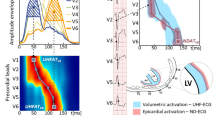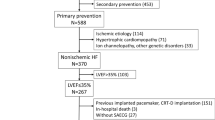Abstract
Early detection of arrhythmias after congenital heart disease surgery is important because it can help decrease morbidity and mortality. Standard electrocardiograms (ECGs) contain frequencies between 0.05 and 100 Hz, but higher frequencies are also present. Using high-resolution technology, the highest amplitudes of these high-frequency components within the QRS complex can be recorded and analyzed. We studied the relationship between ventricular late potentials, ventricular arrhythmias and right ventricular systolic pressure in 22 patients who underwent tetralogy of Fallot repair (mean follow-up, 40.1 ± 33.5 months). Holter ECG monitoring and signal-averaged electrocardiograms (SAECGs) were performed. SAECG parameters studied included the duration of the filtered QRS, the duration of terminal QRS below 40 μV, and the root mean square amplitude of the terminal 40 msec. Cardiac catheterization was performed on 19 patients. Eighteen healthy volunteers were studied as a control. Ventricular arrhythmias were found in 13 patients; right ventricular systolic hypertension was found in 1 patient. No significant residual ventricular septal defects were detected. Eight patients had ventricular late potentials. Right ventricular systolic pressure did not differ significantly between patients with or without late potentials. There were significant differences between patients with ventricular arrhythmias and healthy volunteers; filtered QRS duration was significantly longer in patients with ventricular arrhythmias. SAECG may be beneficial in determining ventricular arrhythmia risk in tetralogy of Fallot patients postoperatively.
Similar content being viewed by others
References
Abe M, Atsumi N, Matsushita S, Mitsui T (2001) Recovery of high-frequency QRS potentials following cardioplegic arrest in pediatric cardiac surgery. Pediatr Cardiol 22:315–320
Boineau JP, Cox JL (1973) Slow ventricular activation in acute myocardial infarction: a source of re-entrant premature ventricular contraction. Circulation 48:702–713
Brachmann J, Hilbel T, Schweizer M, Kubler W (1993) Cardiac late potentials for diagnosis in heart disease. Eur Heart J (Suppl C) 14:49–51
Breithardt G, Cain ME, el-Sherif N, et al. (1991) Standards for analysis of ventricular late potentials using high resolution or signal-averaged electrocardiography. J Am Coll Cardiol 5:999–1006
Deanfield JE, McKenna WJ, Hallidie-Smith KA (1980) Detection of late arrhythmia and conduction disturbance after correction of tetralogy of Fallot. Br Heart 144:248–253
Denes P, Santarelli P, Hauser RG, Uretz EF (1983) Quantative analysis of the high-firequency components of the terminal portion of the body surface QRS in normal subjects and in patients with ventricular tachycardia. Circulation 67: 1129–1138
Downar E, Harris L, Kimber S, et al. (1992) Ventricular tachycardia after surgical repair of tetralogy of Fallot: results of intraoperative mapping studies. J Am Coll Cardiol 20:648–655
Dreyer WJ, Paridon SM, Fisher DJ, Garson A Jr (1993) Rapid ventricular pacing in dogs with right ventricular outflow tract obstruction: insight into a mechanism of sudden death in postoperative tetralogy of Fallot. J Am Coll Cardiol 21:1731–1737
Freedman RA, Gillis AM, Keren A, Soderholm-Difatte V, Mason JW (1985) Signal-averaged electrocardiographic late potentials in patients with ventricular fibrillation or ventricular tachycardia: correlation with clinical arrhythmia and electrophysiologic study. Am J Cardiol 55:1350–1353
Friedli B (1999) Electrophysiological follow-up of tetralogy of Fallot. J Pediatr Cardiol 46:326–330
Fuster V, McGoon DC, Kennedy MA, Ritter DG, Kirklin JW (1980) Long-term evaluation (12 to 22 years) of open heart surgery for tetralogy of Fallot. Am J Cardiol 46:635–642
Goor DA, Lavoe J, Smolinsky A, et al. (1981) Correction of tetrad of Fallot with reduced incidence of right bundle branch block. Am J Cardiol 48:892–896
Harrison DA, Harris L, Siu SC, et al. (1997) Sustained ventricular tachycardia in adult patients late after repair of tetralogy of Fallot. J Am Coll Cardiol 30:1368–1373
Hayabuchi Y, Matsuoka S, Kubo M, Akita H, Kuroda Y (1994) Age related criteria for signal-averaged electrocardiographic late potentials in children. Pediatr Cardiol 15:107–111
Hegerty A, Anderson RH, Deanfield JE (1988) Myocardial fibrosis in tetralogy of Fallot: effect of surgery or part of natural history? [Abstract] Br Heart J 59:123
Hofmann T, Burmeister A, Meinertz T (2004) Prognostic significance of the signal averaged electrocardiogram in patients with chronic stable coronary artery disease. Analysis in the time domain and by spectral temporal mapping. Z Kardiol 93:32–42
Horneffer PJ, Zahka KG, Rowe SA, et al. (1990) Long-term results of total repair of tetralogy of Fallot in childhood. Ann Thorac Surg 50:179–185
James FW, Kaplan S, Chou TC (1975) Unexpected cardiac arrest in patients after surgical correction of tetralogy of Fallot. Circulation 52:691–695
Murphy JG, Gersh BJ, Mair DD, et al. (1993) Long-term outcome in patients undergoing surgical repair of tetralogy of Fallot. N Engl J Med 329:593–599
Nalos PC, Gang ES, Mandel WJ, et al. (1987) The signal-averaged electrocardiogram as a screening test for inducibility of sustained ventricular tachycardia in high risk patients; a prospective study. J Am Coll Cardiol 9:539–548
Ryan M, Lown B, Horn H (1975) Comparison of ventricular ectopic activity during 24-hour monitoring and exercise testing in patients with coronary artery disease. N Engl J Med 292:224–229
Silka MJ, Hardy BG, Menashe VD, Morris CD (1998) A population-based prospective evaluation of risk of sudden cardiac death after operation for common congenital heart defects. J Am Coll Cardiol 32:245–251
Stelling JA, Danford DA, Kugler JD, et al. (1990) Late potentials and inducible ventricular tachycardia in surgically repaired congenital heart disease. Circulation 82:1690–1696
Vaksmann G, el Kohen M, Lacroix D, et al. (1993) Influence of clinical and hemodynamic characteristics on signal-averaged electrocardiogram in postoperative tetralogy of Fallot. Am J Cardiol 71:317–321
Vaksmann G, Fournier A, Davignon A, et al. (1990) Frequency and prognosis of arrhythmias after operative correction of tetralogy of Fallot. Am J Cardiol 66:346–349
Zimmermann M, Friedli B, Adamec R, Oberhansli I (1991) Ventricular late potentials and induced centricular arrhythmias after surgical repair of tetralogy of Fallot. Am J Cardiol 67:873–878
Author information
Authors and Affiliations
Corresponding author
Rights and permissions
About this article
Cite this article
Omeroglu, R.E., Olgar, S. & Nisli, K. Signal-Averaged Electrocardiogram May Be a Beneficial Prognostic Procedure in the Postoperative Follow-Up Tetralogy of Fallot Patients to Determine the Risk of Ventricular Arrhythmias. Pediatr Cardiol 28, 208–212 (2007). https://doi.org/10.1007/s00246-006-1157-y
Published:
Issue Date:
DOI: https://doi.org/10.1007/s00246-006-1157-y




